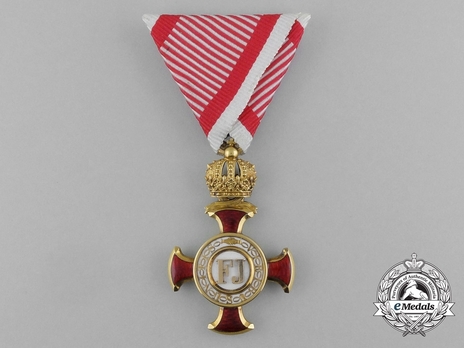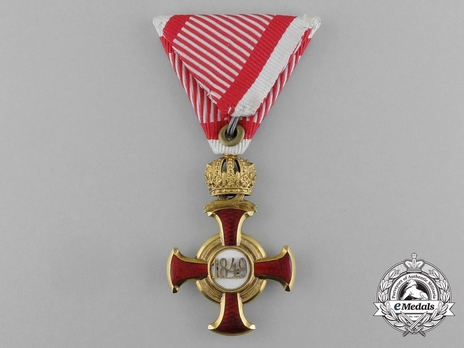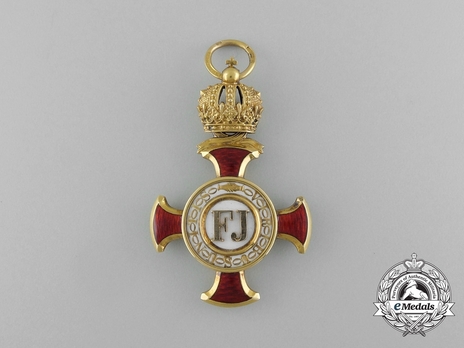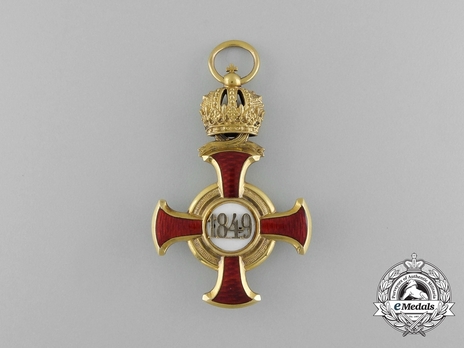Merit Cross "1849", Type III, I Class Cross (with crown) by V. Mayer & Sohne
CATEGORY: Version
SKU: 02.AUT.0109.201.01.000
Estimated market value:




Estimated market value:
An Austrian Golden Cross of Merit with Crown in Gold by V. Mayer & Sohn
A fine quality manufacture cased Austrian Cross of Merit with Crown; gold cross pattée with arms in rounded ends, with a gold crown suspension signed “V. Mayers Söhne”, “in Wien”, with the “Gemsenkopf 3A” hallmark for 18k gold; the obverse with a circular central white medallion with “FJ” for “Emperor Franz Joseph” within a gold border and the inscription “Viribus Unitis” (Strength Through Unity); the reverse equally with a circular central white medallion with the institution date “1849”; on a replacement tri-fold wartime ribbon; measuring 55.40 mm x 35.86 mm (with crown); weighing 15.1 grams. Accompanied by its original case of issue; constructed of heavy pressed paper with a textured dark green faux leather exterior; lined interior lid embossed with “V. Mayers Söhne - Hof u. Kammerjuweliere Ordenssfabrikanten Wien” in golden lettering; with a recessed medal bed with room for its ribbon; the exterior dated “1909” and with a stamp reading “843/1909”; functional spring catch with stud release and functional exterior metal hinge; measuring 106 mm x 59 mm; extremely fine condition.
The Imperial Decree of February 16, 1850 announced the creation of the new Cross of Merit to replace the Civil Medals of Honour. This was awarded primarily to civilian achievements. More specifically it was “to reward loyal and actively reliable devotion to Kaiser and Fatherland, long years of fruitful employment in public service or other achievements for the general good.”
The Cross of Merit was originally awarded in four classes, as a ‘gold’ and a ‘silver’ cross each with or without a crown. Multiple awards could be conferred upon the same recipient, and lower levels could still be worn after a higher one was awarded. Women could also be awarded the Cross of Merit, prior to the outbreak of the war.
In September 1914, the Statutes were amended to include soldiers who were away from the front. However, these decorations would be worn on the red and white silk ribbon of the bravery medal. As of February 1916, ‘gold’ crosses were constructed of bronze due to the lack of material during the war.
On April 1, 1916, the “Iron Cross of Merit” was created. It was only to be awarded during the war and only to NCOs. This decoration looked like the gold and silver crosses but used rust-protected iron and was not enamelled. The reverse presents the year 1916. It was awarded to all other ranks and NCOs not in a rank group who were born in 1865 and 1866, who in 1917 were still actively participating in the war were automatically awarded the Iron Cross of Merit. Anyone who had already received this award was provided with a silver bar for the ribbon. In 1918, this provision included the men born in 1867. As the war progressed the composition changed from rust-protected iron to pewter or zinc alloys.
In December 1916, the Decoration could include swords, which indicated achievement in the face of the enemy or in effective leadership of a formation.
In February 1918, it became possible to be awarded the Gold and Silver crosses (with or without crown) more than once, denoted by a gold bar on the ribbon.
The Type III crosses are worn on red (peacetime) ribbon or a wartime ribbon. The wartime ribbon has one thick stripe of white and red along each exterior edge, and thin, alternating horizontal white and red stripes in the centre section. From 1917-1918 the Type III the crosses could also be awarded with crossed swords on the wartime ribbon.
The I and III Class decorations (with crown) either show a common crown or a Rudolph Crown, particularly when manufactured by the Schneider Brothers in Vienna. The latter crown has visible arched points on each side.
The inscription VIRIBUS UNITIS translates to “With United Forces.”

Comments
Sign in to comment and reply.


Scroll Top